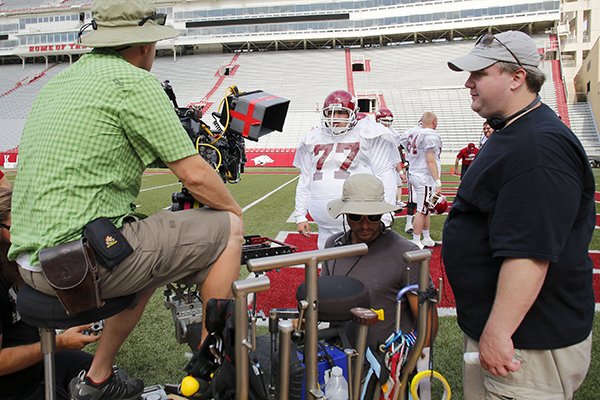FAYETTEVILLE — It has been 17 years since Brandon Burlsworth died in a car accident on his way to his hometown of Harrison, but the late Arkansas all-American is still part of Brian Reindl’s life every day.
Reindl, a lifelong Razorbacks fan from Fayetteville, has spent the better part of the past decade working to preserve both Burlsworth’s memory and his legacy as the greatest walk-on in the history of college football.
Burlsworth is all around Reindl’s office that overlooks the Dickson Street district in Fayetteville. There is a cutout of him in full uniform behind the desk of Reindl’s secretary. Inside Reindl’s conference room is more memorabilia — Jeff Kinley’s 2001 book “Eyes of a Champion: The Brandon Burlsworth Story”; a poster for Greater, a motion picture film recorded in several Arkansas cities three years ago; and a replica of the Burlsworth Trophy, which is given annually by the Springdale Rotary Club to college football’s best player who began his career as a walk-on.
The movie and trophy were the brainchild of Reindl, whose day job — when he’s not promoting Burlsworth-related projects — is managing rental properties in Northwest Arkansas. The trophy came to fruition six years ago and was first presented in 2011. It has been handed out each December since and has found its niche among college football’s crowded postseason award circuit.
Reindl has found the motion picture scene more difficult to navigate. Nearly a dozen years after envisioning the film and a decade after the first of three screenplays was written, Reindl has yet to get his film in theaters.
It was scheduled to release in January earlier this year, but the premiere was canceled just days before the release date because of a lack of available screens and the popularity of the latest Star Wars movie. It is now scheduled to premiere Aug. 26 at between 400 and 600 theaters nationwide. Reindl is hopeful the new release date will attract football fans similar to the way Remember the Titans did in September 2000.
“There have been a lot of doubters, just like with Brandon Burlsworth,” Reindl said of getting the film to theaters. “I feel like Brandon’s story is special and it had to be good enough to meet up to that standard.
“It has taken an incredible amount of time.”
The interest in Burlsworth is high with the name registering more than 2 billion impressions on Google as of last year, according to Mitchell Communications, which handles publicity for the film and the trophy.
There is a litany of reasons behind its many delays. One came when a Hollywood screen writer, whose name was not given, was hired by Reindl in 2011. But his screenplay didn’t match Reindl’s vision for the film.
“I got to the end and said, ‘I don’t feel anything,’” Reindl said. “That was not what I wanted for the film. I want people to feel something. I want them to cry.”
The script was rejected by, among others, the Burlsworth family.
“I don’t want to say it was laughable, but it was close to it,” said Marty Burlsworth, Brandon’s brother and executive director of the Burlsworth Foundation. “It was almost like they had dissected bits of other sports movies. There were pieces of Rudy, pieces of Hoosiers, pieces of Brian’s Song. You could see what they were trying to mimic.”
Reindl said he waited six months for the failed screenplay and wasn’t able to use anything from it once the writer was removed from the project. The movie’s big break came when Reindl met up with David Hunt, a director from Springdale. The pair began rewriting the screenplay in 2012.
“We were just two Arkansas guys trying to tell an Arkansas-based story,” said Reindl, whose son Jake is a freshman pitcher for the Razorbacks.
The film was shot in 2013 in Fayetteville, Little Rock, Springdale, Harrison, Farmington, Gravette and Lincoln. By the end of 2014, editing was finished.
That delay makes Reindl anxious for this summer’s release. He compares his journey making his first film to Burlsworth’s journey to starting offensive lineman at Arkansas in the 1990s, calling himself a “walk-on filmmaker. I had to learn the whole industry.”
Prior to its failed January release date, private screenings of the film were shown in Arkansas, New York and Los Angeles, which Reindl said resulted in a 98 percent “excellent” or “very good” review from women, and 90 percent rate from men. The film has also been screened at the Pro Football Hall of Fame in Canton, Ohio, and the Hall of Fame has promised to lend its resources in promotional advertising this summer.
Minus a Hollywood screen writer, there will still be some elements of Tinseltown in the film. Don’t expect the storyline to match Burlsworth’s life — or past Arkansas games — to a T.
“Brandon was 23 years old when he died, so we’re trying to squeeze 23 years into two hours,” Reindl said. “There are three things you have to do when making a film: combine characters, compress time and give yourself a creative license.”
But the Burlsworth family says the film tells Brandon’s story well. Reindl calls the film “powerful” and says you can expect it to inspire.
“I like to call it hope-based with faith elements,” Reindl said, “but it’s more like The Blind Side than Facing the Giants.”

